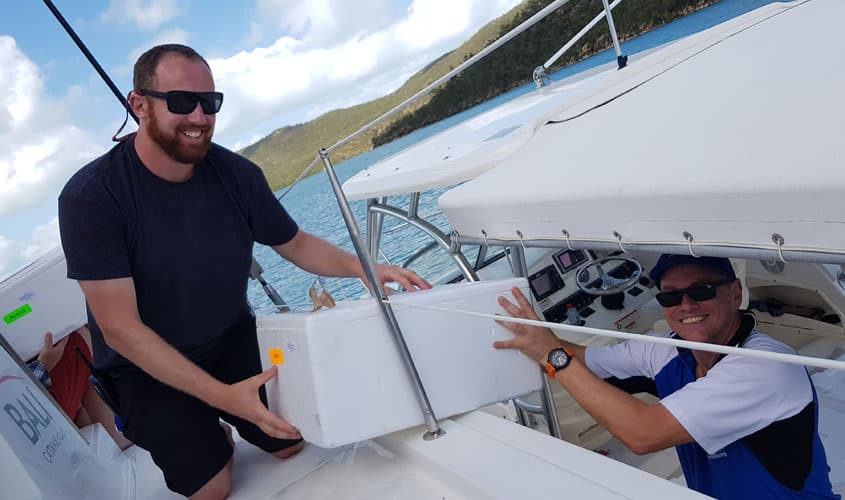To camp in the Whitsundays is to indulge in what many believe to be the ultimate camping experience – sleeping under the stars on a ‘desert isle’. There are many islands to choose from, and the final choice of site may depend on whether you wish to get away from it all, or to be more gregarious. The choice may also depend on a willingness to ‘rough it’ (with no facilities) or to have creature comforts such as picnic tables, a shelter and bush toilets. Transport to the islands is another key factor.
Once you have selected a suitable campsite and arranged transport, a camping permit can be purchased several ways: first, by visiting the Queensland Government’s website; by ringing the QPWS camping permits information line on 13 74 68; Once you have booked and paid for your permit, you will be given a booking number and issued a camping tent tag.
How to get there
The best way to reach these remote campsites is by private boat. Public boat ramps are conveniently located at Shute Harbour, Abel Point, Cannonvale, Dingo Beach, Conway Beach, and Midge Point. For those who prefer a more guided experience, commercial boat tours and transfer services operate out of Shute Harbour and Abel Point Marina, offering camper drop-offs as well. You’ll also find options to hire boats or kayaks.
Ferry services such as Scamper that specialise in camper and kayaker drop-offs are the easiest option. They are used to dealing with the needs of campers and kayakers, and they usually have all the necessary equipment available for hire too.
Water, cooking and waste
Once on the islands, be prepared for the lack of fresh water. You must bring your own supply for drinking, cooking, washing, and bathing. A minimum of five litres per person per day is recommended. Additionally, campfires and ash-producing barbecues are prohibited. Ensure you have a gas or fuel stove for cooking to comply with park regulations.
As you enjoy your surroundings, remember to pack out everything you bring in. Waste disposal facilities are not available on the islands, so all rubbish must be carried back to the mainland for proper disposal. Generators and other motorised equipment are also prohibited, preserving the tranquility and natural sounds of this pristine environment.
Camping requires advance planning. Reservations can be made up to 11 months ahead, and early booking is advisable during peak seasons. Several campsites are well-positioned for activities like hiking and snorkelling. South Molle Island’s Sandy Bay and Paddle Bay offer excellent walking tracks, while snorkelers will appreciate Maureens Cove and Crayfish Beach on Hook Island.
Keeping safe & well
While mobile phone coverage is patchy and largely dependent on your provider, satellite phones offer more reliable connectivity in these remote areas.
The weather is generally favourable year-round, though the wet season from January to April brings higher chances of rain, and cyclones are more likely between November and March. Always check the Bureau of Meteorology’s forecasts before your trip to ensure you’re prepared for changing conditions.
Wildlife encounters are part of the Whitsundays experience. Goannas, brush turkeys, and other animals are common and can become a nuisance if food isn’t securely stored. Use sealed containers to keep your provisions safe and never leave food or waste unattended.
Marine stingers are a concern from October to May, but they may be present year-round. Protective clothing is essential when swimming or snorkelling, and carrying vinegar is a highly recommended safety measure. Sharks inhabit these waters, with Cid Harbour on Whitsunday Island known for past incidents. Following shark safety guidelines and keeping waters clean by avoiding food or fish waste disposal is critical.
Saltwater crocodiles also inhabit the region and are especially active during the summer wet season. Stay alert near mainland water in partiucular and exercise caution at all times. They have been occasionally sighted around the islands.
Rules within the marine national park
Domestic animals, including dogs, are not allowed in the Whitsundays’ national parks or on their beaches, helping to protect the delicate ecosystem.
Fishing is popular but strictly regulated. Many areas, including Whitehaven Beach and Butterfly Bay, fall within Marine National Park zones where fishing is prohibited. Consult marine park zoning maps to stay compliant, and check seasonal fin fish closures.
For those who wish to collect marine souvenirs, specific limits apply and it’s best to be cautious. Habitat Protection and General Use zones permit limited collecting, but no coral, living or dead, may be taken without a permit. Watch out you don’t put a cone shell in your pocket, or you’ll be in for a nasty and potentially fatal surprise.
Spearfishing has its own set of restrictions. It’s allowed in certain zones, but areas within the Whitsunday Special Management Area and others regulated under Queensland fisheries laws have additional prohibitions. Always consult the relevant guidelines before spearfishing.
Public moorings are available at many anchorages, with posted instructions for proper use and time-limits apply (e.g. 24 hours). Anchoring inside No Anchoring Areas is prohibited; instead, aim for sandy or muddy spots away from fragile coral ecosystems. You will likely need a tender to get to shore.
Personal watercraft users should note that motorised water sports are only permitted in designated areas. Direct routes between destinations are allowed, but adherence to the Whitsundays Plan of Management is required.
Get this information and more, such as campsite locations, getting to the islands and tropical tips in the latest edition of , 100 Magic Miles of the Great Barrier Reef – The Whitsunday Islands.






